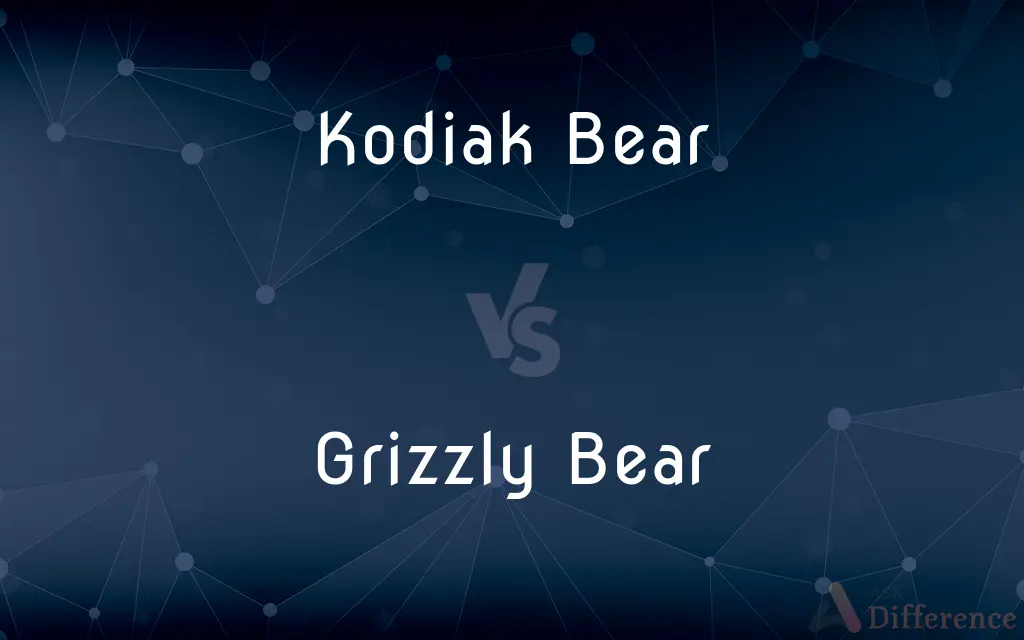Kodiak Bear vs. Grizzly Bear — What's the Difference?
Edited by Tayyaba Rehman — By Fiza Rafique — Published on December 26, 2023
Kodiak Bear is a subspecies of brown bear, lives on Kodiak Archipelago. Grizzly Bear is a North American subspecies of the brown bear, identified by a pronounced shoulder hump.

Difference Between Kodiak Bear and Grizzly Bear
Table of Contents
ADVERTISEMENT
Key Differences
Kodiak Bears are a unique subspecies of the brown bear, residing primarily in the Kodiak Archipelago in Alaska. Grizzly Bears, another subspecies, are native to North America and are recognized by their distinct shoulder hump and less coastal habitat than the Kodiak.
Kodiak Bears are among the largest of all bears due to a diet rich in salmon and relatively isolated habitat. Grizzly Bears are slightly smaller, with their size and diet varying significantly depending on their specific environment.
Kodiak Bears, due to their isolated habitat, have fewer threats from human activities and maintain a more stable population. Grizzly Bears, spread across North America, often face challenges like habitat loss and conflicts with humans.
Kodiak Bears have a relatively uniform appearance with a large size and typically blond to orange or even sometimes dark brown fur. Grizzly Bears show more variety in fur color, ranging from blond to black, and often have "grizzled" fur tips.
Both Kodiak Bears and Grizzly Bears play a crucial role in their ecosystems. They help regulate prey populations and, through their foraging habits, contribute to nutrient dispersal. However, Kodiak Bears, due to their size, have fewer natural predators than Grizzly Bears.
ADVERTISEMENT
Comparison Chart
Subspecies
Ursus arctos middendorffi
Ursus arctos horribilis
Size
Among the largest bears
Generally smaller than Kodiak
Habitat
Kodiak Archipelago, Alaska
North America, diverse habitats
Appearance
Large size, blond to dark brown fur
Shoulder hump, "grizzled" fur
Human Interaction
Limited due to isolation
More frequent, sometimes leading to conflict
Compare with Definitions
Kodiak Bear
Kodiak Bears are a large subspecies of brown bears found exclusively on the Kodiak Islands in Alaska.
We spotted a Kodiak Bear feasting on salmon during our trip to Alaska.
Grizzly Bear
Grizzly Bears are known for their "grizzled" fur, with its typical brown shade highlighted by lighter tips.
The Grizzly Bear's fur seemed to shimmer with different hues in the bright sunlight.
Kodiak Bear
Kodiak Bears have a diet primarily consisting of fish, thanks to the abundant salmon in their habitat.
The Kodiak Bear's diet contributes significantly to its impressive size.
Grizzly Bear
Grizzly Bears have a varied diet that includes fish, plants, and large mammals.
We watched a Grizzly Bear skillfully hunt a large mammal during our wilderness tour.
Kodiak Bear
Kodiak Bears are known for their immense size, often standing over 10 feet tall when on their hind legs.
The enormous Kodiak Bear loomed by the riverbank, an awe-inspiring sight.
Grizzly Bear
Grizzly Bears are a North American subspecies of brown bears, identifiable by their pronounced shoulder hump.
The Grizzly Bear's distinct silhouette was visible against the forest backdrop.
Kodiak Bear
Kodiak Bears have a thick coat that ranges in color from blonde to orange and even sometimes dark brown.
The Kodiak Bear's fur glistened in the sun, highlighting the variety of shades in its coat.
Grizzly Bear
Grizzly Bears, while powerful predators, also eat berries, roots, and insects.
I saw a Grizzly Bear foraging for berries and roots, a reminder of their varied diet.
Kodiak Bear
Kodiak Bears, while generally solitary, are observed to congregate in areas with plentiful food sources.
Several Kodiak Bears were seen together during the salmon run, ignoring their usual solitary nature.
Grizzly Bear
Grizzly Bears play a vital role in the ecosystem, helping to regulate prey populations.
The park's Grizzly Bear population is a key factor in maintaining the area's ecological balance.
Common Curiosities
How does a Grizzly Bear differ from other bears?
Grizzly Bears have a distinct shoulder hump and "grizzled" fur, setting them apart.
How big are Kodiak Bears?
Kodiak Bears are among the largest bears, some standing over 10 feet tall on hind legs.
What is a Kodiak Bear?
A Kodiak Bear is a large subspecies of brown bear found on Alaska's Kodiak Islands.
Can Grizzly Bears climb trees?
Young Grizzly Bears can climb trees, but adults are often too heavy.
What do Grizzly Bears eat?
Grizzly Bears have a varied diet, including fish, plants, insects, and large mammals.
Are Kodiak Bears aggressive?
Kodiak Bears are generally peaceful but can be aggressive if provoked or threatened.
Do Kodiak Bears have natural predators?
Adult Kodiak Bears have no natural predators due to their size.
When are Grizzly Bears most active?
Grizzly Bears are most active during dawn and dusk.
How do Kodiak Bears catch their prey?
Kodiak Bears primarily fish for salmon but can also hunt mammals and forage.
How fast can a Kodiak Bear run?
A Kodiak Bear can run at speeds of up to 30 mph for short distances.
Are Grizzly Bears endangered?
Some Grizzly Bear populations are stable, but others are endangered due to habitat loss.
What's the lifespan of a Kodiak Bear?
Kodiak Bears can live about 20-25 years in the wild.
How do Grizzly Bears hibernate?
Grizzly Bears hibernate in dens, slowing their metabolism to conserve energy.
Share Your Discovery

Previous Comparison
Arabs vs. Indians
Next Comparison
Detritivores vs. DecomposersAuthor Spotlight
Written by
Fiza RafiqueFiza Rafique is a skilled content writer at AskDifference.com, where she meticulously refines and enhances written pieces. Drawing from her vast editorial expertise, Fiza ensures clarity, accuracy, and precision in every article. Passionate about language, she continually seeks to elevate the quality of content for readers worldwide.
Edited by
Tayyaba RehmanTayyaba Rehman is a distinguished writer, currently serving as a primary contributor to askdifference.com. As a researcher in semantics and etymology, Tayyaba's passion for the complexity of languages and their distinctions has found a perfect home on the platform. Tayyaba delves into the intricacies of language, distinguishing between commonly confused words and phrases, thereby providing clarity for readers worldwide.
















































